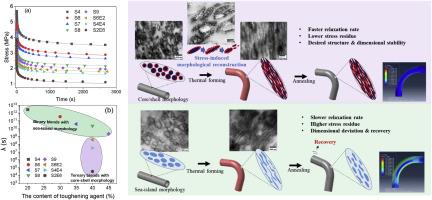A novel mechanism to accelerate stress relaxation of toughened blends: Stress-induced core-shell morphological reconstruction and its application in thermoforming and dimensional stabilization
IF 12.7
1区 材料科学
Q1 ENGINEERING, MULTIDISCIPLINARY
引用次数: 0
Abstract
Improving thermoforming efficiency and dimensional stability in thermoplastic products is a common challenge. This study investigates toughened polyamide 612 (PA612) blends made by adding maleic anhydride-functionalized SEBS (mSEBS) elastomers, along with high-density polyethylene (HDPE), polyphenylene Oxide (PPO), and polyphenylene Sulfide (PPS). Analyses showed that mSEBS forms a core-shell structure with HDPE or PPO and a sea-island structure with PPS in the PA612 matrix. The study uniquely examines how these structures affect stress relaxation. The results, modeled by a steady-state creep model, revealed that the core-shell structures reduced the characteristic relaxation time (λ) by over three orders of magnitude compared to PA612/mSEBS blends. Additionally, PA612/mSEBS/HDPE blends were more temperature-sensitive, reducing λ by six orders of magnitude compared to PA612/mSEBS/PPO blends. Further analysis showed that stress-induced core-shell morphological reconstruction (SCMR) significantly improved stress relaxation by promoting extensive plastic deformation and energy dissipation. These toughened PA612 blends exhibited excellent thermoforming efficiency and dimensional stability. A 3D finite element model confirmed SCMR as an effective strategy for stress relaxation, providing valuable insights for designing toughened blends with superior processing efficiency and stability.

加速增韧共混物应力松弛的新机制:应力诱导的核壳形态重构及其在热成型和尺寸稳定中的应用
提高热塑性产品的热成型效率和尺寸稳定性是一项共同的挑战。本研究调查了通过添加马来酸酐功能化 SEBS(mSEBS)弹性体以及高密度聚乙烯(HDPE)、聚苯氧化物(PPO)和聚苯硫醚(PPS)制成的增韧聚酰胺 612(PA612)混合物。分析表明,mSEBS 与 HDPE 或 PPO 形成核壳结构,与 PA612 基质中的 PPS 形成海岛结构。该研究独特地考察了这些结构如何影响应力松弛。通过稳态蠕变模型模拟的结果显示,与 PA612/mSEBS 混合物相比,核壳结构将特征松弛时间 (λ)缩短了三个数量级以上。此外,PA612/mSEBS/HDPE 共混物对温度更敏感,与 PA612/mSEBS/PPO 共混物相比,λ 降低了六个数量级。进一步的分析表明,应力诱导的核壳形态重构(SCMR)通过促进广泛的塑性变形和能量耗散,显著改善了应力松弛。这些增韧的 PA612 共混物具有出色的热成型效率和尺寸稳定性。三维有限元模型证实了 SCMR 是一种有效的应力松弛策略,为设计具有卓越加工效率和稳定性的增韧共混物提供了宝贵的见解。
本文章由计算机程序翻译,如有差异,请以英文原文为准。
求助全文
约1分钟内获得全文
求助全文
来源期刊

Composites Part B: Engineering
工程技术-材料科学:复合
CiteScore
24.40
自引率
11.50%
发文量
784
审稿时长
21 days
期刊介绍:
Composites Part B: Engineering is a journal that publishes impactful research of high quality on composite materials. This research is supported by fundamental mechanics and materials science and engineering approaches. The targeted research can cover a wide range of length scales, ranging from nano to micro and meso, and even to the full product and structure level. The journal specifically focuses on engineering applications that involve high performance composites. These applications can range from low volume and high cost to high volume and low cost composite development.
The main goal of the journal is to provide a platform for the prompt publication of original and high quality research. The emphasis is on design, development, modeling, validation, and manufacturing of engineering details and concepts. The journal welcomes both basic research papers and proposals for review articles. Authors are encouraged to address challenges across various application areas. These areas include, but are not limited to, aerospace, automotive, and other surface transportation. The journal also covers energy-related applications, with a focus on renewable energy. Other application areas include infrastructure, off-shore and maritime projects, health care technology, and recreational products.
 求助内容:
求助内容: 应助结果提醒方式:
应助结果提醒方式:


